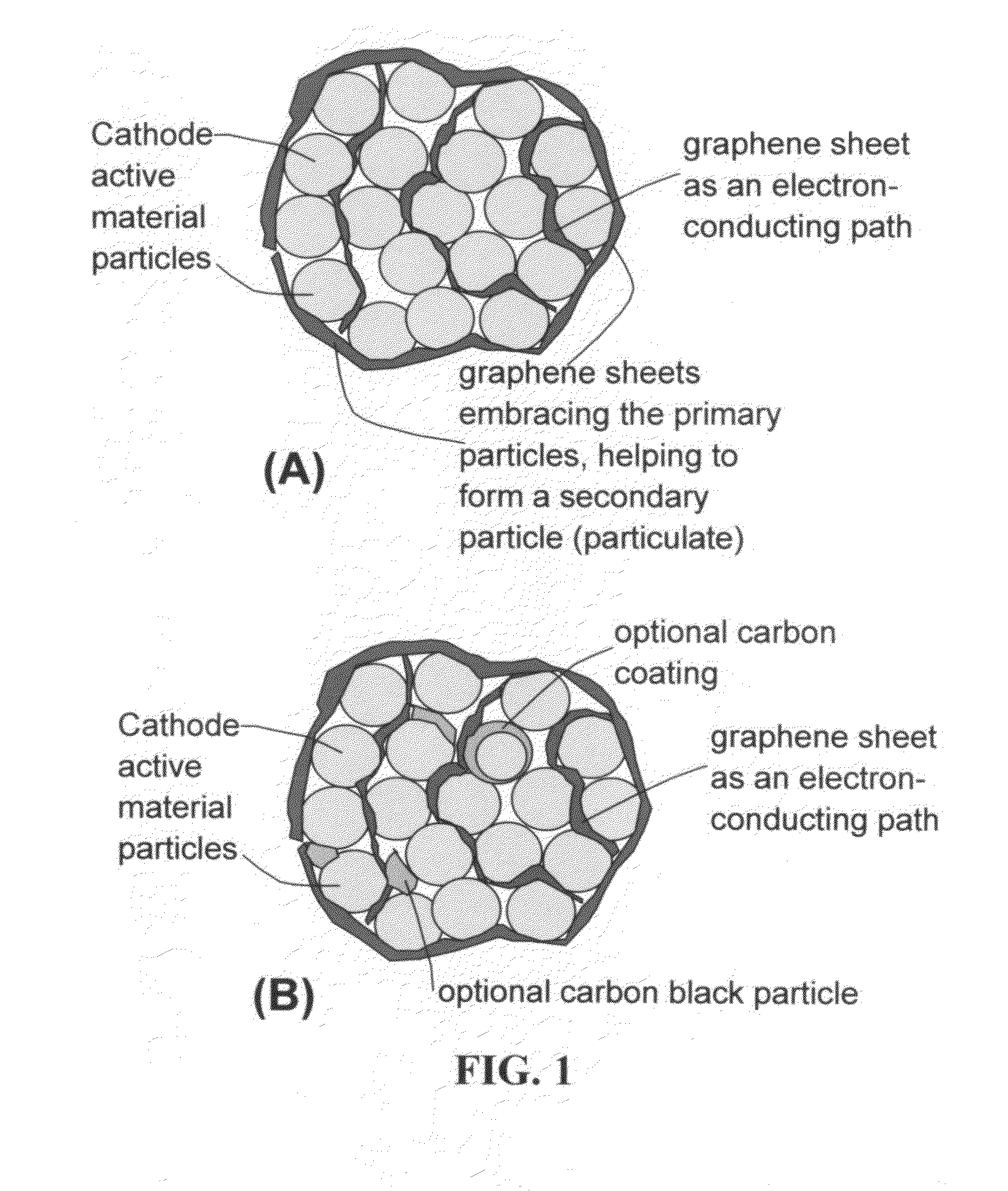Graphene-Enhanced cathode materials for lithium batteries
a lithium battery and graphene-enhanced technology, applied in the direction of non-metal conductors, cell components, conductors, etc., can solve the problems of insatiable, the specific capacity of the more commonly used cathode active materials is already very low, and the problem is further aggravated, etc., to achieve faster battery charge and discharge rate, short lithium diffusion time
- Summary
- Abstract
- Description
- Claims
- Application Information
AI Technical Summary
Benefits of technology
Problems solved by technology
Method used
Image
Examples
example 1
Graphene Oxide from Sulfuric Acid Intercalation and Exfoliation of MCMBs
[0069]MCMB 2528 microbeads were supplied by Alumina Trading, which was the U.S. distributor for the supplier, Osaka Gas Chemical Company of Japan. This material has a density of about 2.24 g / cm3 with a median particle size of about 22.5. MCMB 2528 (10 grams) were intercalated with an acid solution (sulfuric acid, nitric acid, and potassium permanganate at a ratio of 4:1:0.05) for 48 hours. Upon completion of the reaction, the mixture was poured into deionized water and filtered. The intercalated MCMBs were repeatedly washed in a 5% solution of HCl to remove most of the sulphate ions. The sample was then washed repeatedly with deionized water until the pH of the filtrate was neutral. The slurry was dried and stored in a vacuum oven at 60° C. for 24 hours. The dried powder sample was placed in a quartz tube and inserted into a horizontal tube furnace pre-set at a desired temperature, 800° C. for 30 seconds to obta...
example 2
Oxidation and Exfoliation of Natural Graphite
[0071]Graphite oxide was prepared by oxidation of graphite flakes with sulfuric acid, sodium nitrate, and potassium permanganate at a ratio of 4:1:0.05 at 30° C. for 48 hours, according to the method of Hummers [U.S. Pat. No. 2,798,878, Jul. 9, 1957]. Upon completion of the reaction, the mixture was poured into deionized water and filtered. The sample was then washed with 5% HCl solution to remove most of the sulfate ions and residual salt and then repeatedly rinsed with deionized water until the pH of the filtrate was approximately 7. The intent was to remove all sulfuric and nitric acid residue out of graphite interstices. The slurry was dried and stored in a vacuum oven at 60° C. for 24 hours.
[0072]The dried, intercalated (oxidized) compound was exfoliated by placing the sample in a quartz tube that was inserted into a horizontal tube furnace pre-set at 1,050° C. to obtain highly exfoliated graphite. The exfoliated graphite was dispers...
example 3
Preparation of Electrodes
[0074]Several dry electrodes containing graphene-enhanced particulates (comprising lithium cobalt oxide or lithium iron phosphate primary particles embraced by graphene sheets) were prepared by mixing the particulates with a liquid to form a paste without using a binder such as PVDF. The paste was cast onto a surface of a piece of glass, with the liquid medium removed to obtain a dry electrode (Sample 3a). Another dry electrode was prepared by directly mixing LiFePO4 primary particles with graphene sheets in an identical liquid to form a paste without using a binder. Again, the paste was then cast to form a dry electrode (Sample 3b). The dry electrodes were for the evaluation of the effect of various conductive additives on the electrical conductivity of an electrode.
[0075]For comparison purposes, several additional dried electrodes were prepared under exactly identical conditions, and the paste in each case was made to contain the same cathode active partic...
PUM
| Property | Measurement | Unit |
|---|---|---|
| electrical conductivity | aaaaa | aaaaa |
| size | aaaaa | aaaaa |
| electrical conductivity | aaaaa | aaaaa |
Abstract
Description
Claims
Application Information
 Login to View More
Login to View More - R&D
- Intellectual Property
- Life Sciences
- Materials
- Tech Scout
- Unparalleled Data Quality
- Higher Quality Content
- 60% Fewer Hallucinations
Browse by: Latest US Patents, China's latest patents, Technical Efficacy Thesaurus, Application Domain, Technology Topic, Popular Technical Reports.
© 2025 PatSnap. All rights reserved.Legal|Privacy policy|Modern Slavery Act Transparency Statement|Sitemap|About US| Contact US: help@patsnap.com



